
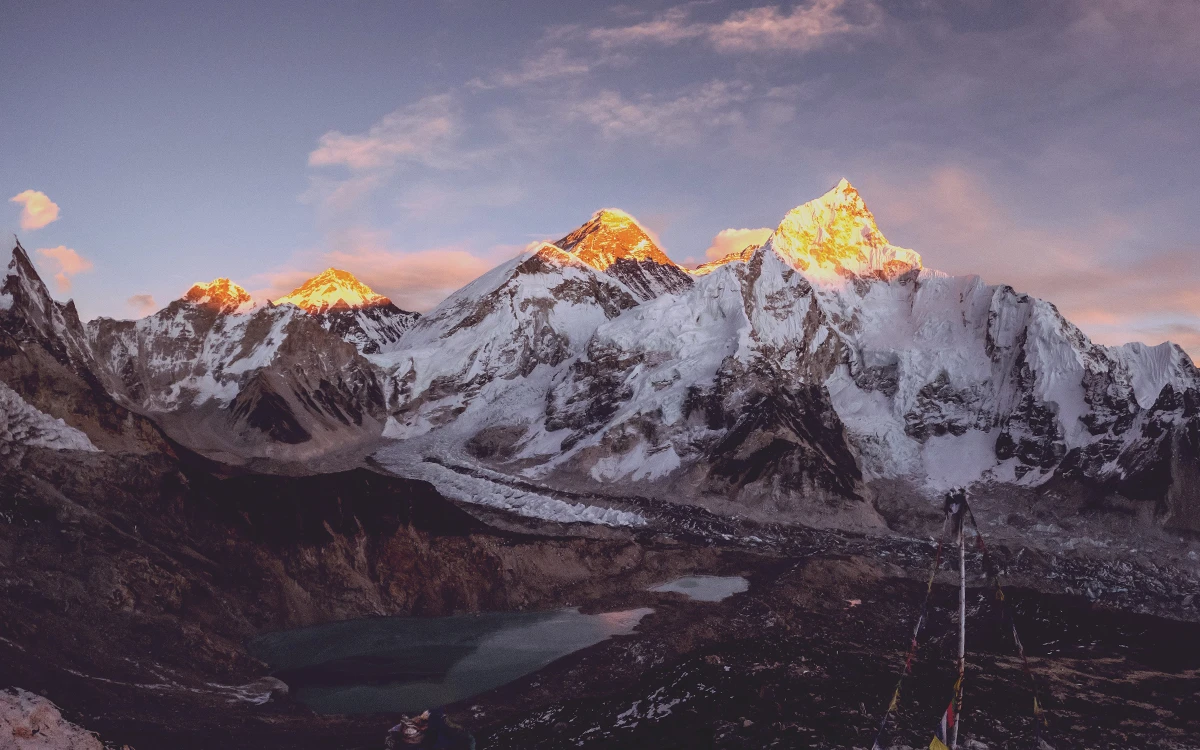
Everest Base Camp Lodge Trek is a popular itinerary among Himalayan adventure enthusiasts! It’s also ideal for those limited by time or budget, offering the perfect Himalayan experience.
During this trek, you will venture through the breathtaking Khumbu Valley, which is also known as Nepal's Everest Valley. Prepare to be amazed by the towering mountains, charming villages, and ancient monasteries that you'll encounter along the way.
The Everest Base Camp Lodge Trek begins with a scenic flight to Lukla Airport at an elevation of 2800m, also known as Hillary Airport, built in 1964. Lukla serves as the gateway to the Everest Region, whether you aim to summit Everest or explore the surrounding trekking routes. It is the starting point for your Everest journey. During this trek, you will traverse various Sherpa villages such as Namche, Khumjung, Tengboche, and Pangboche, as well as other charming villages like Phakding, Monjo, Dingboche, Lobuche, and Gorakshep.
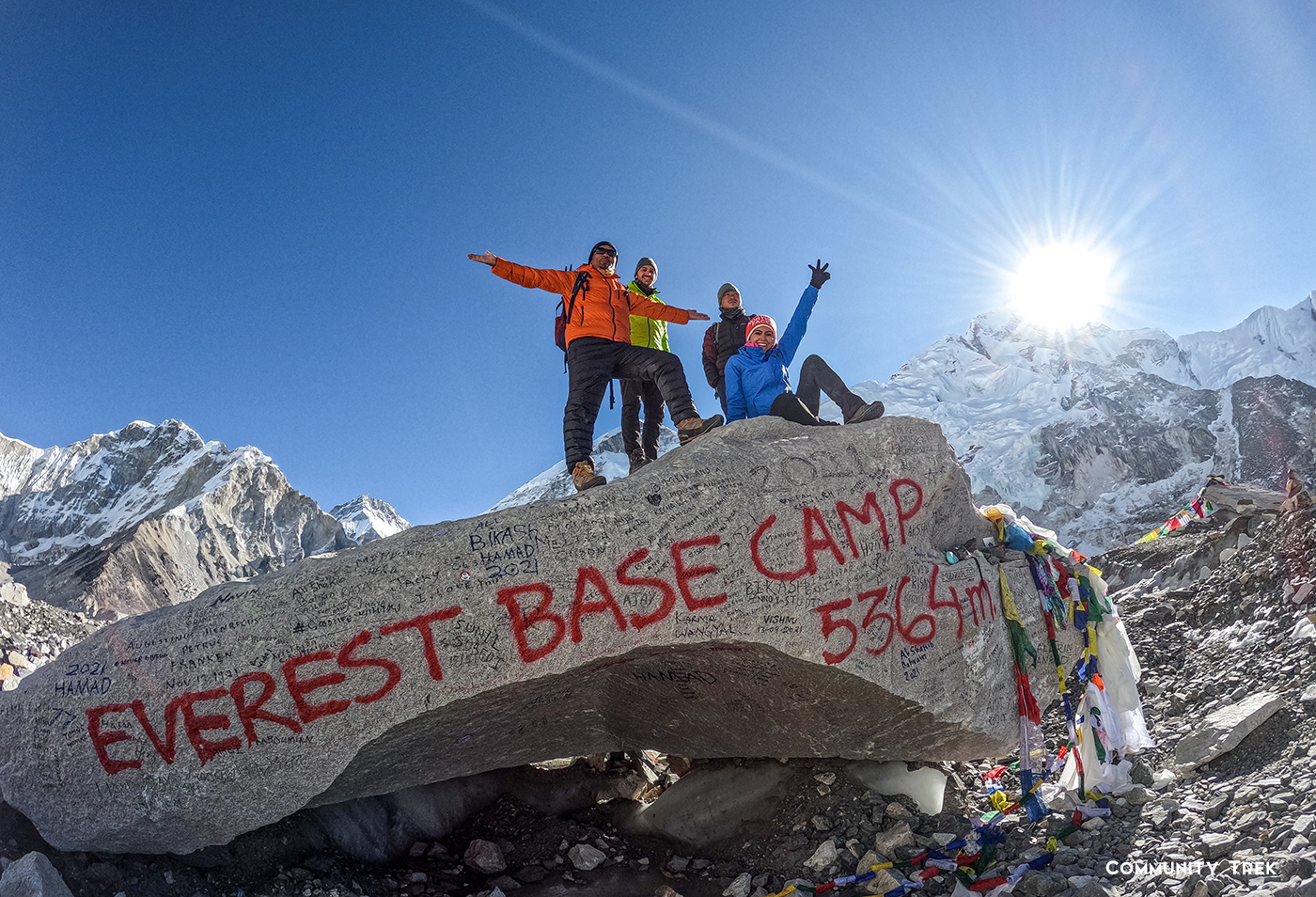
The trail offers a mesmerizing journey through the high Himalayan landscape, featuring majestic 8000-meter peaks, glacier rivers, and breathtaking views of glaciers and the Khumbu icefall. You'll have the opportunity to reach Everest's close-up vantage point, such as Kalapathar.
Your journey begins with a scenic flight to Lukla Airport (2800m), often referred to as Hillary Airport. Established in 1964, Lukla is the gateway to the Everest Region, marking the start of your unforgettable adventure.
The trek culminates at Everest Base Camp (5464m), offering one of the most iconic and breathtaking views of Mount Everest and the surrounding peaks.
Expect to be awe-struck by the majestic 8000-meter peaks, glacier rivers, glaciers, and the famous Khumbu icefall. You’ll also have the chance to reach Kalapathar for a closer view of Everest.
The Everest Base Camp trek is ideal for those who are physically fit and have experience with multi-day treks. Our carefully designed itineraries prioritize acclimatization, ensuring a comfortable pace with well-placed stops.
While the ascent is generally gradual, expect a few steeper sections, particularly to Namche, Tengboche, and Kalapathar. On average, you’ll walk 5 to 7 hours per day. Porters will carry most of your gear, leaving you with just a daypack.
You’ll stay in comfortable mountain lodges with clean rooms. However, in Lobuche and Gorakshep, accommodations may be more basic due to the higher altitude.
The optimal times to trek to Everest Base Camp are during the spring (March-May) and autumn (September-November) seasons. These months offer clear skies, stable weather, and minimal rainfall—though expect more crowds and higher prices during peak seasons.
Thrilling Mountain Flight to Lukla: Begin your adventure with an exhilarating flight to Lukla’s Tenzing-Hillary Airport, one of the most exciting airstrips in the world, surrounded by breathtaking mountain scenery.
Trekking Through Diverse Landscapes: Experience the beauty of the Himalayas as you trek through lush valleys, and dense forests, and cross suspension bridges. Along the way, you'll pass Buddhist monasteries and traditional Sherpa villages, immersing yourself in the local culture.
Panoramic Views from Kala Patthar: Reach the summit of Kala Patthar at 5,545 meters for unparalleled panoramic views of Mount Everest and other snow-capped peaks. This is one of the trek’s most iconic moments.
Explore Everest Base Camp: Stand at the legendary Everest Base Camp, situated at an altitude of 5,364 meters, and get an up-close view of the Khumbu Icefall, one of the most challenging sections of the Everest ascent.
|
|
|
|---|---|
| 2-5 People | USD 1850 |
| 6-12 People | USD 1750 |
Your guide will arrive early at your hotel to pick you up, ready to drive you to either Kathmandu Airport (KTM) or Manthali Airport (RHP). From there, a thrilling flight awaits, taking you to Lukla, a mountain airstrip situated at an impressive altitude of 9,190 feet (2,800 meters) above sea level. During this short journey, you'll be treated to breathtaking views as you soar over the picturesque Dudh Kosi ("Milk River") valley. Upon landing in Lukla, you'll descend from a small hill and enter a lush, forested valley. The trail meanders through the vibrant landscape, offering tantalizing glimpses of the adventure that lies ahead. Eventually, you'll reach the charming village of Phakding, your home for the first night of this unforgettable trek.
Take on at Lukla Airport 2800m.
Note: Please inform us of your available time before the trip begins for the trip briefing and a meeting with your guide. You can also reach us on WhatsApp at any time, from anywhere, by contacting us at +9779808881190, or you may choose to email us at info@communitytrek.com.
From Phakding, you follow the Dudh Kosi north through magnificent forests with glimpses of the mountains ahead. You cross the river several times by bridge as you pass through the villages of Benkar, Monzo, and Jorsale. A final bridge brings you to the foot of the steep climb to Namche Bazaar. Halfway up the ascent, you may get your first glimpse (cloud permitting) of the Everest summit behind the great ridge of Nuptse-Lhotse. A last 985ft (300m) climb brings you to Namche Bazaar, the Sherpa capital, and the main town in the area.
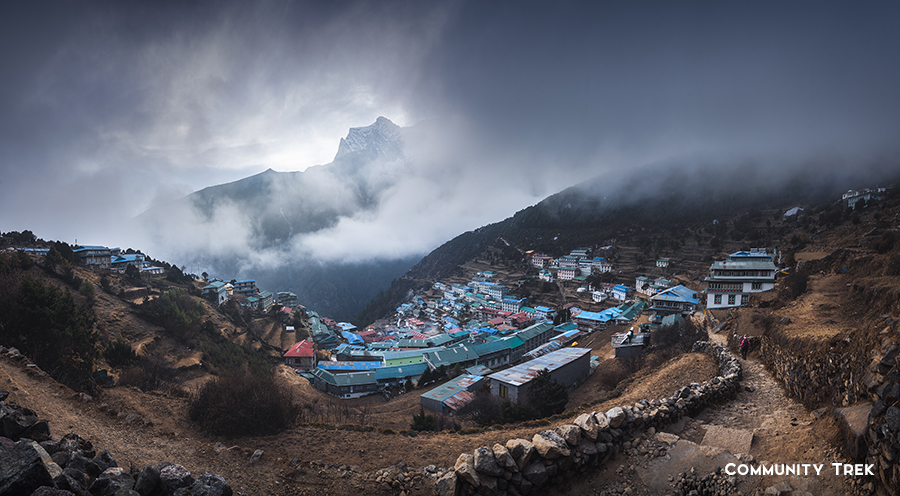
Namche Bazar is a prosperous Sherpa town and an important trading center. It has a weekly market on Friday afternoons and Saturday mornings, but the town always bustles with trekkers, coffee shops, bakeries, and stores selling all kinds of trekking and climbing gear and Tibetan souvenirs.
Today is dedicated to acclimatization in Namche Bazaar, a crucial step involving walking at higher elevations and sleeping at lower altitudes. After breakfast, get on a hike to Everest View Hotel at 3810m, where a brief tea break awaits, offering stunning panoramic views of Everest. Next, descend to Khumjung Sherpa Village for a lunch break, exploring the monastery and Hillary School, before returning to Namche. This day of hiking is designed to aid your body in acclimatizing effectively to the surrounding altitude.
Everest View Hotel 3880m.
After breakfast, your day begins as you head towards the next destination. The initial 45 minutes involve ascending, followed by a gradual flat trail until reaching Kyanjuma Village. Continuing, the path ascends gradually until Mungla Dada, where a hot lunch awaits with the best views. Afterward, descend to Phortse Thanga, cross a small bridge, and embark on a one-hour ascent to Phortse Sherpa Village. Phortse is not only home to Everest summiteers but also boasts a rich wildlife-filled atmosphere in its surroundings.
Phortse Village, Khumbu, Everest
Today, the landscape undergoes a dramatic transformation as we trek through a zone renowned for its abundant wildlife. The journey begins with the first village, Pangbuche, where you can take a break for hot tea before continuing towards Somare for lunch. Post-lunch, the trek progresses towards Dingbuche Village. Along the way, engage in conversations and enjoy face-to-face encounters with Mount Ama Dablam, considered one of the most beautiful mountains in the world.
Dingbuche Village 4410m.
Today marks your second acclimatization day in Dingboche Village, a strategic step in preventing altitude sickness by hiking high and sleeping low. Following breakfast, seize the opportunity to ascend Nangkartshang Peak (16,730 ft/5,100m). From the summit, revel in breathtaking views of Makalu, Lhotse, Chalotse, Tawoche, and Ama Dablam. For those acclimatizing well, a challenging three-hour and thirty-minute climb to the top is an option, while a halfway climb is available for those feeling less energetic. Despite the difficulty, the awe-inspiring vistas make the journey worthwhile. After descending, return to Dingboche for a late lunch, leaving the remainder of the afternoon for relaxation and further acclimatization.
Dingbuhce View Point 4700m.
The trail ascends steeply out of Dingboche, passing a chorten, and gradually climbs the valley to Thukla, located at the terminal moraine's end of the Khumbu Glacier. A tea break and snack await here before the challenging ascent to Thukla Pass, a poignant spot adorned with memorials to climbers who lost their lives on Everest. From Thukla Pass, a magnificent panorama of the Mount Amadablam range unfolds. The trail then eases as we follow the valley to Lobuje, a quaint hamlet with a few teahouses. In the late afternoon, consider walking up onto the lateral moraine of the Khumbu Glacier, where the sunset on Nuptse is a spectacle not to be missed.
Thukla Pass 4900m.
Today is a challenging day as we trek from Lobuche to Gorak Shep. The trail goes up and down along the rocky moraine of the Khumbu Glacier, and it takes about three hours to reach Gorak Shep. There are no lodges from Gorak Shep to Everest Base Camp, so we fill our water bottles and grab snacks.
After a break in Gorak Shep, we walk across a sandy flat area and climb onto the rocky moraine of the glacier. The trail goes up for a couple of hours before coming down onto the rocky moraine itself. We pass fascinating ice formations called seracs and reach Everest Base Camp. In spring, we might see climbers preparing to climb the mountain. At Base Camp, we get close-up views of the Khumbu Ice Fall, understanding the challenges climbers face negotiating through massive ice blocks. After a quick photo stop at the Base Camp rock, we return to Gorak Shep for an overnight stay.
Everest Base Camp 5364m.
Note that accommodation options are limited at Gorak Shep, and the teahouse is basic. The communal dining area is warm, and food is served quickly. Due to the high altitude, plumbing facilities can be affected, and water may freeze often.
The trek to Kala Patthar starts early in the morning, so you can catch the sunrise over the mountains. The trail is steep and strenuous, but the views make it all worth it. The altitude can also be a challenge, so it's important to take your time and acclimatize to the higher altitude. Once you reach the summit, you'll be rewarded with stunning views of the Himalayas, including Mount Everest, Lhotse, Makalu, and many other peaks. The views are truly breathtaking, and you'll feel a sense of accomplishment for reaching the summit.
Kalapatthar View Point 5660m.
After you've enjoyed the views, it's time to head back down. The trail is steep, but it's much easier going down than it is up. You'll return to Gorak Shep for breakfast before beginning the descent through the valley, past yaks and rivers to the village of Pangbuche.
Today, our extensive trekking day begins early. In comparison to previous days, it will feel relatively easier as you descend from Pangboche to Tengboche and Namche. The walk starts with a 45-minute ascent from Debuche to Tengboche and approximately 1:30 minutes ascent from Phungithanga to Kyangjuma. The overall trail is well-defined, leading you to Namche. We'll spend the night in Namche Bazaar.
After breakfast in Namche Bazaar, descend to the renowned Hillary Bridge and continue your walk to Manju, Phakding, and finally Lukla. The total walking distance for today is approximately 17.7km, taking around 7 hours.
Today marks your last night in the mountains, and it's a tradition to celebrate with a small party including your trekking crew. You can provide drinks and food as a gesture of appreciation for their hard work, making the final evening more memorable for the entire team. Expressing gratitude through tips will not only make the crew happier but also bring a different kind of happiness to your journey's conclusion.
We take a flight back to Kathmandu and transfer you to your hotel. If your return from Lukla falls between April 10 and May 10, 2023, during the spring season, the flight will land in Manthali on one of the first flights of the day, around 7-7:30 am. This timing allows for a 5-6 hour bus transfer back to Kathmandu, with an expected arrival in the city during the mid-late afternoon. Your journey with Community Trek is now complete. If you're interested in other trips or tours, feel free to discuss with us, and we'll assist you in arranging anything you desire.
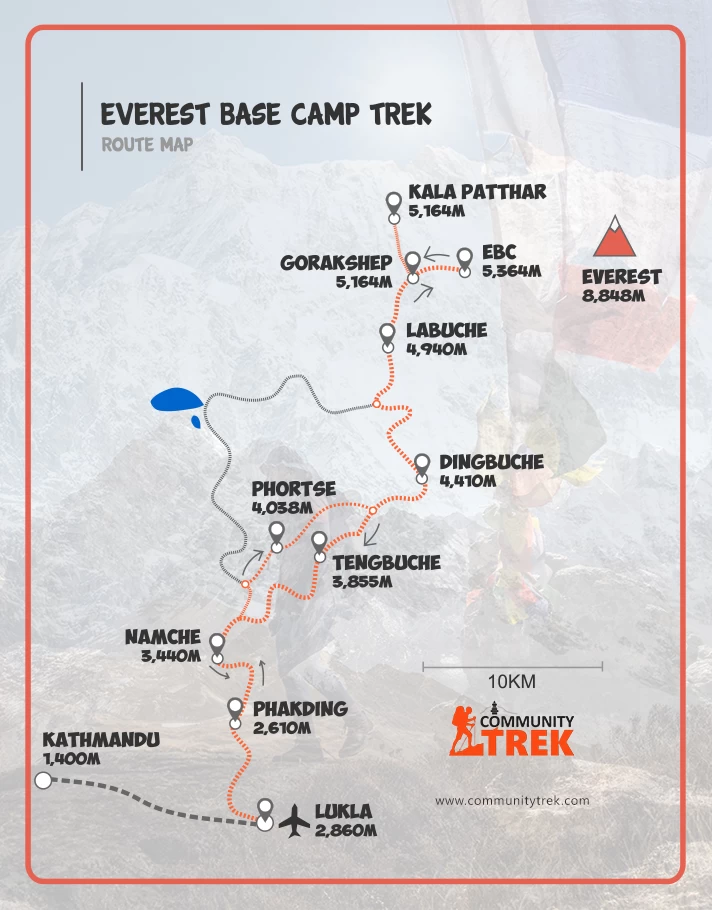
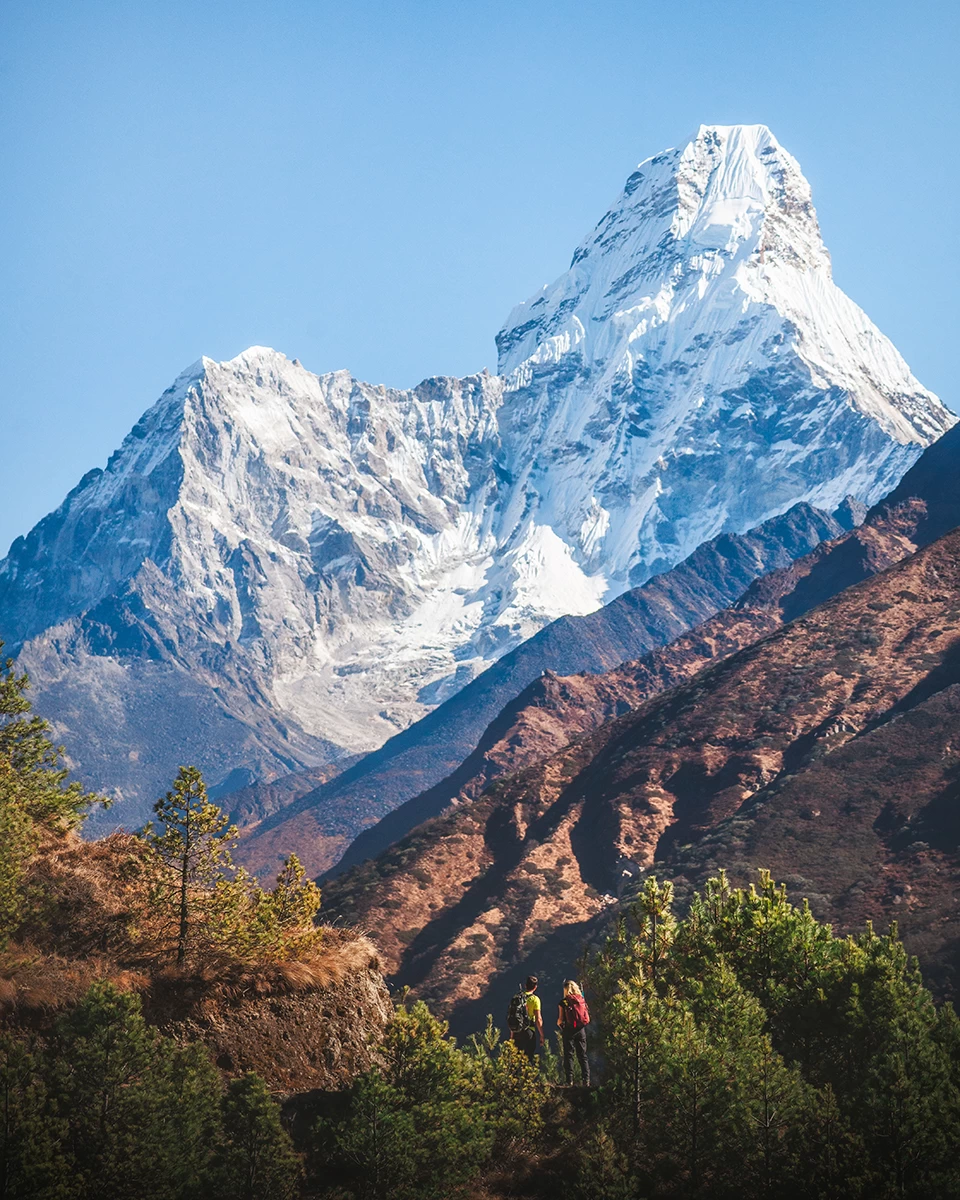
| Departure | Return | Duration | Price From |
|---|
Please complete the form to submit your application.
Step 1: Tell us about yourself.
Fill out the Booking Form with as much information as possible.
Step 2: Pay 30% of your deposit.
Once the deposit has been paid, you have secured your position.
Step 3: Get excited and start preparing. You will receive regular contact about your upcoming trip and how to prepare.
Mountain Lodge: The Everest Base Camp Trek offers basic lodge accommodations with twin beds, mattresses, and blankets. Most lodges have dining halls heated with yak dung and a restaurant. For added warmth, recommend bringing your own sleeping bag and liner. Rooms may not have charging ports or attached toilets. Meals are typically provided at the lodge where you stay.
Sharing Rooms: Rooms are typically shared with one other person. Solo travellers can be paired with a same-gender roommate, while those travelling with others can share a room. You can request separate arrangements, with single rooms available for an extra fee.
Battery Charging: Charging stations are typically located in the lodge's dining area, with fees ranging from USD 1-3 per hour, depending on the device. Charging power banks usually incur a higher fee. Many lodges use solar panels for power, which may be unreliable during bad weather. A portable battery charger (15,000-20,000mAh) is recommended to ensure you have enough power for multiple charges.
Cellular Network: Consider an international calling plan from your home provider for reliable service. If you prefer a Nepali SIM card, Nepal Telecom (NTC) generally offers better coverage in remote areas compared to Ncell, though reception may still be limited in some places. SIM cards cost $1-2 and can be purchased in Kathmandu. You'll need to provide a passport copy and a passport-sized photo for their records. A 10GB data pack, costing $5-10, should be sufficient for 1-2 weeks, depending on your data usage.
Wi-Fi: You can purchase Wi-Fi each night from teahouses for $5-10. They offer plans with unlimited access for 12 hours or 24 hours. However, internet speeds can be slow and patchy in remote areas.
Hot Showers: Hot showers (solar or gas) are available for a fee of 4-7 US $ per shower. Above 4,000 meters, only bucket showers are provided.
Toilets: Shared toilets are common, with options ranging from Western to squat styles. Attached toilets are rare at higher elevations, and running water may not be available. Bring your toilet paper and soap.
Mountain Flights: Mountain flights operate exclusively in the mornings, offering a thrilling and picturesque experience. These flights use Twin Otter planes, which can accommodate approximately 18 passengers. Common carriers include Summit Air, Tara Air, and Sita Air.
Vehicle: We provide reserved private vehicles for all your transportation needs, including pick-ups and drop-offs according to the itinerary. The type of vehicle-whether a car, jeep, or will be chosen based on the number of passengers and the terrain.
Food: Lunch and dinner are not included in the price, giving you full flexibility to choose meals based on your appetite and preferences. The lodges offer a decent selection of food and drink options. For vegetarians, vegans, or those with dietary restrictions, please let us know at the time of booking so we can make appropriate arrangements.
Water: Carrying your own water bottle or hydration pack is mandatory. It's recommended to have a bottle (1.5-2 litres) and a thermal flask (1 litre or smaller) during the trek. You can refill your bottle with boiled or bottled drinking water available at lunch spots and hotels. We strongly discourage buying plastic water bottles during the trek to minimize environmental impact.
Snacks: It's recommended to bring snacks (like chocolates, dry fruits, etc.) and energy bars to munch on during the trek.
Shops Along the Way: You'll encounter several well-stocked shops along the trails (especially in the lower elevations) where you can purchase water, snacks, and toiletries. There are also shops selling tea and beverages between lunch stops.
Our team consists of experienced and reliable tour leaders, guides, trek leaders, climbing leaders, and porters who are used to living in high altitudes.
We are committed to providing our clients with the best possible Himalayan experience. Our team is dedicated to your safety and enjoyment, and we will do everything we can to make your trek a success.
Additional Expenses: Beyond meals, potential expenses include drinks, laundry, tipping, and shopping. Please review the "Prices" section carefully to understand additional costs you may encounter during your trip.
Emergency Fund: While our trips are meticulously planned, unforeseen circumstances (like political unrest, strikes, bad weather, natural calamities, poor road conditions, airport closures, flight cancellations, etc.) can arise. For this reason, we recommend setting aside Rs. 25,000 as an emergency fund.
Currency: It's advisable to carry Nepali rupees for the trials, as most service providers transact in this currency.
ATMs and Credit Cards: Cash is the preferred payment method in most areas outside major cities. While some hotels and eateries in popular towns accept cards, reliability can be an issue. Card transactions may incur a 3-4% transaction fee. ATMs are limited in smaller towns, so carrying sufficient cash is recommended.
Tipping: A suggested guideline is USD 15 per day for guides and USD 12 per day for porters. Feel free to tip more if you're particularly pleased. Tips can be given in Nepali rupees or US dollars. Typically, the group pools money together to tip guides and porters on the final day of the trek during dinner.
Cancellations and Refunds: In case of flight delays or cancellations due to bad weather or unforeseen circumstances, we'll reschedule at no extra cost. However, any additional expenses incurred due to changes (including transportation, accommodation, and food) will be the trekker's responsibility.
Altitude Sickness: We take altitude sickness seriously and design our itineraries for a gradual ascent, covering shorter distances at higher elevations. To acclimatize, we stay an extra night at the same location or similar altitude after significant elevation gains.
During the trek, we prioritize hydration, avoid alcohol, and conduct acclimatization hikes as needed. Our guide will monitor your vitals with an oximeter daily to assess your body's response to altitude changes. If you experience AMS symptoms or headaches, please inform your guide immediately. Mild headaches can often be managed with food, hydration, and rest. While we generally don't recommend Diamox (altitude sickness pills), you may consider taking them as a precaution if you're coming from sea level.
Trail Safety: Our guide carries a well-equipped first-aid kit at all times. Please review our equipment and medical checklist for better preparedness, as common issues like foot blisters and knee pain can be addressed with proper packing. If you have pre-existing health conditions, please inform us upon booking.
Keep your passport, flight tickets, phone, wallet, camera equipment, cash, and valuables in your daypack or waist belt. Avoid bringing expensive items like jewellery or large amounts of cash for security reasons.
Insurance: Obtaining travel insurance that covers emergency evacuation (including helicopter rescue) and medical expenses up to 5,500 meters (18,044 feet) above sea level is mandatory.
Drinking Water: Water safety is paramount. To avoid waterborne diseases, we recommend drinking only boiled water or using steriPEN, LifeStraw, or purification tablets during the trek.
Immunization: Recommended immunizations before trekking in Nepal include Hepatitis A, Typhoid fever, and chickenpox. While not strictly enforced, they are for your safety.
Emergency Contacts: In case of issues or emergencies, please contact the lead guide or any team member. They can assist with contacting nearby hospitals, transportation, ambulances, police offices, army checkpoints, and embassies, and facilitate rescue operations. We'll provide a list of relevant emergency contacts before your trip.
What to Pack: Kathmandu offers many gear shops where you can purchase or rent essential items. If you forget anything, Thamel is a convenient place to buy it before your trek. You can rent items like a sleeping bag for around USD 2-3 per day.
What Not to Carry: At the airport, items such as oxygen cylinders, drones, satellite phones (without permission), and sharp objects like knives and scissors may be confiscated.
Check the Trekking Checklist here..
Leave No Trace: Please avoid littering and dispose of all trash properly; you can hand it to your guide. Refrain from plucking flowers or vandalizing trails. Let's keep the trails as pristine as we found them.
Rules and Conduct: Physical violence, verbal abuse, harassment, solicitation, and the use or possession of illegal drugs or materials are strictly forbidden.
Alcohol and Drugs Policy: Excessive alcohol consumption can dehydrate you and affect your trekking safety. We advise limiting alcohol intake during the day and saving any drinks for the evening.
No Handouts: Do not give money or handouts to beggars or children, as it encourages a culture of begging.
Photography and Drones: Always ask for permission before photographing locals, though many are happy to be photographed. Note that drone usage is strictly regulated in Nepal, so please avoid flying drones.
Traveling in a Group: Group travel offers a mix of ages, fitness levels, and paces. Please respect the schedule set by your guide to ensure a smooth experience for everyone.
Passport: All foreign visitors to Nepal must possess a valid passport with a minimum of 6 months validity beyond their planned departure date.
Visa: Nepal visa can be obtained on arrival at Kathmandu airport (Tribhuvan International Airport) or you can obtain Nepal visa prior to your arrival through the Nepalese embassies, diplomatic missions and consulates near your location. Nepal Visa is also issued at the entry points if you are entering Nepal by land.
Visa Fees: Nepal visa fees are listed below as per the duration.
Multiple entry 15 days – US$ 30 or equivalent convertible currency
Multiple entry 30 days – US$ 50 or equivalent convertible currency
Multiple entry 90 days – US$ 125 or equivalent convertible currency
Important Note: It is always advisable to verify the visa requirements upon booking your trip. Visa requirements may vary depending on where you are from and its also recommended to check the transit country requirements as well.
While we share this information in good faith, it is crucial for you to independently verify it and acknowledge that you bear full responsibility for your visa requirements.

Without a doubt, Trekking Nepal with Team RAMESH and Community Trek was the most incredible experience I've shared with my colleagues. These incredible guides, hailing from a mountain village nestled in the lower Everest region, possess an intimate knowledge of the region and its people. Walking alongside them, we felt a comfort and genuine connection that surpassed expectations. Their expertise and passion for their homeland ensured our trek was not just enjoyable, but truly unforgettable. If you're planning a Nepalese adventure, I wholeheartedly recommend Community Trek and Team RAMESH – you won't be disappointed.

I had a great experience with Community Trek traveling and trekking in Nepal. I learned more about the culture, the local history and the mountains, things that made this experience more valuable. The team were helpful and lovable. They did an amazing job guiding our group to accomplishing the EBC.

Our adventure to Everest Base Camp with Ramesh was an incredible one. I can’t put into words how much fun we had as a group. Ramesh was easily the best, friendliest and most knowledgeable guide on the mountain. His support in us and passion for what he does is second-to-none, there’s no one I’d rather trek with! Our trek to Base Camp was one that took us all out of our comfort zone but certainly something I’m glad to have been able to achieve. I’d certainly love to visit Ramesh and Nepal again. What a journey!
Write Your Review
Give Review